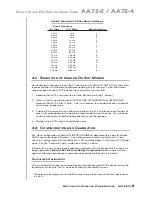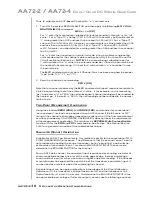
C
ONFIGURATION AND
C
ALIBRATION
1.G
OF
A
NALOG
I
NPUT
C
HANNELS
1.G.2
M
ETHODS OF
C
ALIBRATION
System 10 channels requiring CALIBRATION are those that contain physical mea-
surement data from the “real world.” These include
•
“REAL” (ANALOG INPUT) CHANNELS
“sourced” by Daytronic SIGNAL CON-
DITIONER CARDS*
•
Peak Capture / Track-Hold
channels based on “real” channels (for the cali-
bration of channels derived from the
Model 10A79-4 Analog Peak Capture
Card
, see Section 3.A.4 of this Guidebook)
All other channel types—”PSEUDOCHANNELS,” “CONVERSION CHANNELS,”
etc.—do not require calibration.**
In most cases, several alternative calibration methods will be available for a data
channel originating from a given Conditioner Card. Which method you choose
will depend on
•
the type of source transducer for the channel
•
the precise characteristics of the transducer/cable/conditioner combination
•
the extent of your knowledge of these characteristics
•
the possibility and/or convenience of producing actual or simulated transduc-
er inputs of accurately known value
In general terms, you will calibrate a signal-conditioner channel by commanding
the System 10 Central Processor to compute and store two constant values: a
SCALING FACTOR (“m”)
—also called “multiplier” or “gain” factor—and a
ZERO
OFFSET (“b”)
. Automatically and continuously applied to all subsequent read-
ings of the given channel, these two CALIBRATION CONSTANTS define the linear
proportionality expressed by the equation
y = mx + b
, where “y” is the measure-
ment value reported for the channel and “x” is the ratio of the actual voltage of the
analog input signal to the positive full-scale voltage of the channel’s chosen input
“TYPE.” As such, “x” is a unitless number operated upon by the “slope” coeffi-
cient “m” and the offset term “b” to yield a true analog measurement. Both “m”
(
EMM
) and “b” (
BEE
) are to be expressed in the engineering units of the chosen
input “TYPE.”
PLEASE NOTE:
As explained in Section 1.G.3, “ABSOLUTE” calibration of a fre-
quency-, current-, or voltage-measuring channel involves the direct setting of the
channel’s “m” and “b” constants by application of the
SCALING FACTOR (EMM)
and
ZERO OFFSET (BEE)
commands, respectively. For all other calibration
techniques, it is normally the case that both “m” and “b” are automatically calcu-
lated and stored by the Central Processor during the run-time calibration proce-
dure, and are NOT ENTERED DIRECTLY BY THE USER via the
EMM
and
BEE
commands.
In fact, certain
EMM
and
BEE
values (other than the normal defaults) are auto-
matically loaded for certain channel types as soon as those types are defined.
Thus, for a thermocouple-based “real” channel or other channel capable of
“ABSOLUTE (CPU)” calibration, specific “m” and “b” values are loaded as soon as
the channel is “typed.” These values should normally NOT BE CHANGED.
1-34
1.G.2 M
ETHODS OF
C
ALIBRATION
* With the exception of channels based on the
Model 10A35 Encoder Conditioner Card
.
** Except for LINEARIZATION (“LIN”) channels, whose calibration is strictly based on prestored
“look-up” tables (see Section 2.L).
Summary of Contents for System 10
Page 31: ...GETTING YOUR SYSTEM 10 ON THE AIR SB 2 FOR A SIZED MAINFRAMES...
Page 67: ...GETTING YOUR SYSTEM 10 ON THE AIR SB 2 FOR B SIZED MAINFRAMES...
Page 122: ...THIS PAGE INTENTIONALLY BLANK...
Page 134: ...1 12 THIS PAGE INTENTIONALLY BLANK...
Page 142: ...1 20 THIS PAGE INTENTIONALLY BLANK...
Page 150: ...1 28 THIS PAGE INTENTIONALLY BLANK...
Page 174: ...10A16 4C 6 THIS PAGE INTENTIONALLY BLANK 10A16 4C QUAD PLATINUM RTD CARD...
Page 186: ...10A18 4C 8 THIS PAGE INTENTIONALLY BLANK 10A18 4C QUAD PLATINUM LINEAR RTD CARD...
Page 212: ...10A40 8 THIS PAGE INTENTIONALLY BLANK 10A40 FREQUENCY CARD...
Page 224: ...10A43 4 THIS PAGE INTENTIONALLY BLANK 10A43 DWELL ANGLE CARD...
Page 234: ...10A48 6 THIS PAGE INTENTIONALLY BLANK 10A48 FLOW CARD...
Page 242: ...10A61 2 4 THIS PAGE INTENTIONALLY BLANK 10A61 2 DUAL 4 20 MA CARD...
Page 252: ...10A63 2 6 THIS PAGE INTENTIONALLY BLANK 10A63 2 DUAL DC VOLTAGE CARD...
Page 270: ...10A69 4 6 THIS PAGE INTENTIONALLY BLANK 10A69 4 QUAD AC RMS CARD...
Page 276: ...10A70 2 6 THIS PAGE INTENTIONALLY BLANK 10A70 2 DUAL DC STRAIN GAGE CARD...
Page 288: ...10A72 2C 12 THIS PAGE INTENTIONALLY BLANK 10A72 2C ENHANCED DUAL DC STRAIN GAGE CARD...
Page 320: ...10A74 4C 18 THIS PAGE INTENTIONALLY BLANK 10A74 4C QUAD DC STRAIN GAGE TRACK HOLD CARD...
Page 342: ...10A96 8 THIS PAGE INTENTIONALLY BLANK 10A96 AMPLIFIED ACCELEROMETER VIBRATION CARD...
Page 362: ...AA30 4 12 THIS PAGE INTENTIONALLY BLANK AA30 4 QUAD LVDT CARD...
Page 374: ...AA41 2 4 12 THIS PAGE INTENTIONALLY BLANK AA41 2 AA41 4 DUAL QUAD FREQUENCY CARD...
Page 390: ...AA72 2 4 16 THIS PAGE INTENTIONALLY BLANK AA72 2 AA72 4 DUAL QUAD DC STRAIN GAGE CARD...
Page 394: ...1 32 THIS PAGE INTENTIONALLY BLANK...
Page 404: ...1 42 THIS PAGE INTENTIONALLY BLANK...
















































